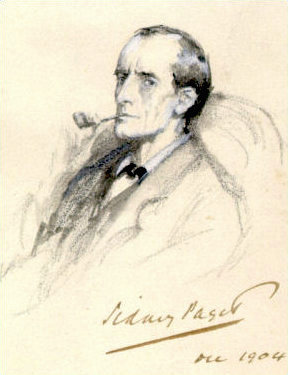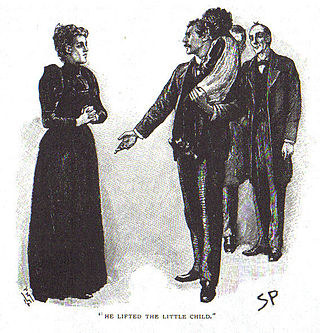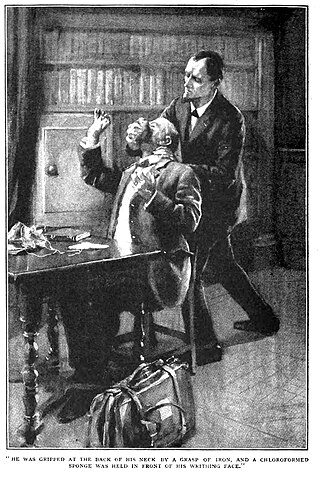Related Research Articles

Nineveh, also known in early modern times as Kouyunjik, was an ancient Assyrian city of Upper Mesopotamia, located in the modern-day city of Mosul in northern Iraq. It is located on the eastern bank of the Tigris River and was the capital and largest city of the Neo-Assyrian Empire, as well as the largest city in the world for several decades. Today, it is a common name for the half of Mosul that lies on the eastern bank of the Tigris, and the country's Nineveh Governorate takes its name from it.

Sherlock Holmes is a fictional detective created by British author Arthur Conan Doyle. Referring to himself as a "consulting detective" in his stories, Holmes is known for his proficiency with observation, deduction, forensic science and logical reasoning that borders on the fantastic, which he employs when investigating cases for a wide variety of clients, including Scotland Yard.

Philip St. John Basil Rathbone MC was an Anglo-South African actor. He rose to prominence in the United Kingdom as a Shakespearean stage actor and went on to appear in more than 70 films, primarily costume dramas, swashbucklers, and, occasionally, horror films.

William Hooker Gillette was an American actor-manager, playwright, and stage-manager in the late 19th and early 20th centuries. He is best remembered for portraying Sherlock Holmes on stage and in a 1916 silent film.

"The Adventure of the Empty House", one of the 56 Sherlock Holmes short stories written by Sir Arthur Conan Doyle, is one of 13 stories in the cycle collected as The Return of Sherlock Holmes. It was first published in Collier's in the United States on 26 September 1903, and in The Strand Magazine in the United Kingdom in October 1903.

"The Adventure of the Musgrave Ritual" is a short story by Arthur Conan Doyle, featuring his fictional detective Sherlock Holmes. The story was originally published in The Strand Magazine in the United Kingdom in May 1893, and in Harper's Weekly in the United States on 13 May 1893. It was collected in The Memoirs of Sherlock Holmes.

Norman Shelley was a British actor, best known for his work in radio, in particular for the BBC's Children's Hour. He also had a recurring role as Colonel Danby in the long-running radio soap opera The Archers.

"The Adventure of the Yellow Face", one of the 56 short Sherlock Holmes stories written by Sir Arthur Conan Doyle, is the third tale from The Memoirs of Sherlock Holmes. It was first published in The Strand Magazine in the United Kingdom in February 1893, and in Harper's Weekly in the United States on 11 February 1893.

"The Adventure of the Reigate Squire", also known as "The Adventure of the Reigate Squires" and "The Adventure of the Reigate Puzzle", is one of the 56 Sherlock Holmes short stories written by Sir Arthur Conan Doyle. The story was first published in The Strand Magazine in the United Kingdom and Harper's Weekly in the United States in June 1893. It is one of 12 stories in the cycle collected as The Memoirs of Sherlock Holmes.

"His Last Bow. The War Service of Sherlock Holmes", later titled "His Last Bow: An Epilogue of Sherlock Holmes", is one of 56 short stories about Sherlock Holmes written by Sir Arthur Conan Doyle. It was first published in September 1917 in The Strand Magazine and collected as the last of an anthology of eight stories titled His Last Bow: Some Reminiscences of Sherlock Holmes the following month. The narration is in the third person, instead of the first person narration usually provided by the character of Dr. Watson, and it is a spy story, rather than a detective mystery. Due to its portrayal of British and German spies on the eve of war, its publication during the First World War, and its patriotic themes, the story has been interpreted as a propaganda tool intended to boost morale for British readers.
The stories of Sherlock Holmes by Sir Arthur Conan Doyle have been very popular as adaptations for the stage, and later film, and still later television. The four volumes of the Universal Sherlock Holmes (1995) compiled by Ronald B. De Waal lists over 25,000 Holmes-related productions and products. They include the original writings, "together with the translations of these tales into sixty-three languages, plus Braille and shorthand, the writings about the Writings or higher criticism, writings about Sherlockians and their societies, memorials and memorabilia, games, puzzles and quizzes, phonograph records, audio and video tapes, compact discs, laser discs, ballets, films, musicals, operettas, oratorios, plays, radio and television programs, parodies and pastiches, children's books, cartoons, comics, and a multitude of other items — from advertisements to wine — that have accumulated throughout the world on the two most famous characters in literature."
Sherlock Holmes has long been a popular character for pastiche, Holmes-related work by authors and creators other than Arthur Conan Doyle. Their works can be grouped into four broad categories:
The Quran contains references to more than fifty people and events also found in the Bible. While the stories told in each book are generally comparable, there are also some notable differences.
Imagination Theatre is an American syndicated radio drama program airing on AM & FM radio stations across the United States. It features modern radio dramas. The program first aired in 1996. Originally produced by Jim French Productions, the program is now produced by Aural Vision, LLC.

John H. Watson, known as Dr. Watson, is a fictional character in the Sherlock Holmes stories by Sir Arthur Conan Doyle. Along with Sherlock Holmes, Dr. Watson first appeared in the novel A Study in Scarlet (1887). "The Adventure of Shoscombe Old Place" (1927) is the last work of Doyle featuring Watson and Holmes, although their last appearance in the canonical timeline is in "His Last Bow" (1917).
This article describes minor characters from the Sherlock Holmes stories by Sir Arthur Conan Doyle, and from non-canonical derived works. The list excludes the titular character as well as Dr. Watson, Professor Moriarty, Inspector Lestrade, Mycroft Holmes, Mrs. Hudson, Irene Adler, Colonel Moran, the Baker Street Irregulars, and characters not significant enough to mention.

In the ancient Mediterranean world, the classical compass winds were names for the points of geographic direction and orientation, in association with the winds as conceived of by the ancient Greeks and Romans. Ancient wind roses typically had twelve winds and thus twelve points of orientation, sometimes reduced to eight or increased to twenty-four.
Sherlock Holmes or Puppet Entertainment Sherlock Holmes is a Japanese puppetry television series written by Kōki Mitani and produced and broadcast by NHK. The puppets for the series were designed by Bunta Inoue. The first series of 18 episodes was broadcast on Sundays from 12 October 2014 to 15 February 2015 by NHK Educational TV (ETV); the first six episodes were broadcast by NHK General TV (GTV) in March and August 2014. A special programme was broadcast on 5 October 2014 while a "Sherlock Holmes Award" was broadcast on 28 December 2014. Each episode was rebroadcast on successive Fridays. The programme won the Japan Sherlock Holmes Award on 22 March 2015.
References
- ↑ al-Buḫārī. Ṣaḥīḥ al-Buḫārī, Kitāb Aḥādīṯ al-anbiyāʾ.
- ↑ Hall, Tim. "The Mighty and Mysterious Gods and Goddesses of Wind". Weathersleuth. Retrieved 24 August 2020.
- ↑ Gen. 41:6, 23, 27; Ex. 10:13; 14:21; Job 15:2; 27:21; 38:24; Ps. 48:7; 78:26; Isa. 27:8; Jer. 18:17; Ezek. 17:10; 19:12; 27:26; Hosea 12:1; 13:15; Jonah 4:8; Hab. 1:9
- ↑ "Poems". 1921.